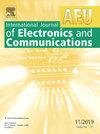Fractional-order bi-Hopfield neuron coupled via a multistable memristor: Complex neuronal dynamic analysis and implementation with microcontroller
IF 3
3区 计算机科学
Q2 ENGINEERING, ELECTRICAL & ELECTRONIC
Aeu-International Journal of Electronics and Communications
Pub Date : 2025-02-01
DOI:10.1016/j.aeue.2025.155661
引用次数: 0
Abstract
The Hopfield neuron is an artificial neuron model used for pattern memorization and recognition. It exhibits a complex dynamic with stable states corresponding to memorized patterns. In order to grasp a more complete representation of the information exchange between two neurons, emphasizing the importance of neuronal connections in brain processing, we propose in this work the coupling of two fractional-order Hopfield neurons via a fractional-order flux-controlled multistable memristor. Each of these two neurons incorporates a self-coupling memristive component, called an autapse memristor. Additionally, the second neuron is subjected to an external electromagnetic radiation, simulated by an additional memristor. The I-V characteristics of the memristors integrated in this model are analyzed through numerical simulations. The simulations of model dynamics versus its diverse parameters have revealed rich and complex dynamical behaviors. These simulations demonstrate that the proposed model generates a variety of homogeneous and heterogeneous chaotic attractors, distributed at diverse locations. The elaborated memristor coupled fractional-order bi-Hopfield neuron MCFBHN model is implemented on an Arduino-Due platform. A comparison of the results of the two approaches shows good consistency.
求助全文
约1分钟内获得全文
求助全文
来源期刊
CiteScore
6.90
自引率
18.80%
发文量
292
审稿时长
4.9 months
期刊介绍:
AEÜ is an international scientific journal which publishes both original works and invited tutorials. The journal''s scope covers all aspects of theory and design of circuits, systems and devices for electronics, signal processing, and communication, including:
signal and system theory, digital signal processing
network theory and circuit design
information theory, communication theory and techniques, modulation, source and channel coding
switching theory and techniques, communication protocols
optical communications
microwave theory and techniques, radar, sonar
antennas, wave propagation
AEÜ publishes full papers and letters with very short turn around time but a high standard review process. Review cycles are typically finished within twelve weeks by application of modern electronic communication facilities.

 求助内容:
求助内容: 应助结果提醒方式:
应助结果提醒方式:


